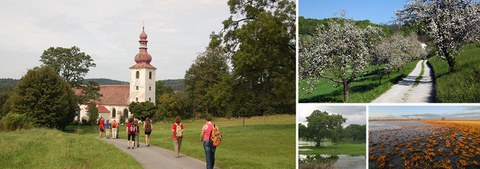TransEcoNet - Landschaften ohne Grenzen
Schutzgebiete, wie Nationalparke, Naturparke oder Biosphärenreservate, sind häufig in sich geschlossene „Inseln“ des Artenschutzes, die durch weniger oder gar nicht geschützte Landschaften, Verkehrsachsen oder Siedlungen voneinander getrennt sind. Die dort lebenden Tier- und Pflanzenarten haben dadurch weniger Raum für Wanderung, Verbreitung und Fortpflanzung zur Verfügung als nötig.
Das von der Professur für Fernerkundung als Lead Partner in den Jahren 2009 bis 2012 durchgeführte CENTRAL EUROPE Projekt TransEcoNet erarbeitete Lösungsansätze, um Schutzgebiete und wenig oder gar nicht geschützten Landschaften über nationale Grenzen hinweg räumlich zu vernetzen.
Im Fokus der (Wieder-)Herstellung von grenzüberschreitenden ökologischen Netzwerken standen dabei wenig oder gar nicht geschützte Räume und deren Verbindungsgrad mit benachbarten Schutzgebieten. Die Untersuchungsregionen lagen innerhalb oder zwischen den weiträumigen ökologischen Netzwerken der Alpen, Karpaten und des Europäischen Grünen Bandes. Daher leistete TransEcoNet einen Beitrag zur pan-europäischen Vernetzung dieser Ökosysteme und zu ihrer nachhaltigen Entwicklung.
Neben der TU Dresden, Professur für Fernerkundung, waren folgende Partner aus den Bereichen Fernerkundung, Geoinformatik, Naturschutz, Landschaftsökologie, Architektur- und Kunstgeschichte sowie Regional- und Umweltwissenschaften, am Projekt beteiligt:
- Leibniz-Institut für ökologische Raumentwicklung (IOER), Dresden (DE)
- Sächsische Landesstiftung Natur und Umwelt (LaNU) – Nationalpark-Informationszentrum Sächsische Schweiz, Bad Schandau (DE)
- Universität Wien (AT)
- Naturschutzbund Burgenland, Eisenstadt (AT)
- Jan-Evangelista Purkyně Universität Ústí nad Labem (CZ)
- The Karkonosze National Park, Jelenia Góra (PL)
- Universität West-Ungarn, Sopron (HU)
- Slowenisches Geodätisches Institut, Ljubljana (SI)
- TU Wien (AT)
- Silva Tarouca Forschungsinstitut für Landschaft und Ziergartenbau, Brno (CZ)
- Böhmische Schweiz gGmbH, Krásná Lípa (CZ)
- Universität Nova Gorica (SI)
- Regionale Entwicklungsagentur Mura, Murska Sobota (SI)



